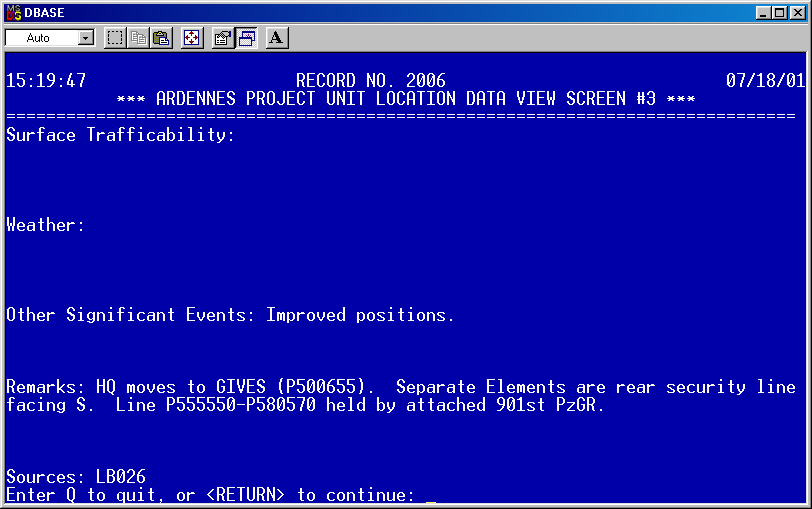
We never seem to stop discussing validation at The Dupuy Institute even though it seems like most of the military operations research community only pays lip service to it. Still, it is something we encourage, even though it has only been very rarely done. A major part of our work over the years has been creation of historical databases for use in combat model validation, combat model testing, and combat model development. Over a series of posts, let me describe what databases are available.
First there are two big campaign databases. These are fairly well known. It is the Ardennes Campaign Simulation Data Base (ACSDB) and the Kursk Data Base (KDB). I was the program manager for both of them.
The ACSDB is a database tracking the actions of all divisions on both sides for every day of the Battle of the Bulge, from 16 December 1944 to 16 January 1945. That was 36 U.S. and British Divisions and 32 German Divisions and Brigades. It tracked the strength, equipment, losses, ammunition and oil for each of these units. The stats on the database are here: http://www.dupuyinstitute.org/data/ardennes.htm
The ACSDB was done from 1987 to 1990 at Trevor Dupuy’s old company, DMSI. There was around 16 or so people involved with it, including consultants like Hugh Cole and Charles MacDonald. We pulled up the units records for all the units on both sides from the U.S. Archives, UK Public Records Office, and the German achives in Freiburg. It was the largest historical database ever created (I do seem to be involved in creating some large things, like my Kursk book).
The database was programmed in Dbase III and is DOS based. The data base was delivered to CAA (Center for Army Analysis). It is publicly available through NTIS (National Technical Information Service). The pictures in this blog post are screen shots from the DBase III version. We do have our own corporate proprietary version re-programmed into Access and with some updates done by Richard Anderson (coauthor of Hitler’s Last Gamble).


Christopher, has the database been updated as more information has become available with the releasing of records by the USA and British Governments. The British only started releasing Ultra information regarding Lorenz from 2000, and not all. I have seen a PHD dissertation by an American Officer Roger Cirillo 2001 supervised by Professor Richard Holmes MARKET GARDEN Campaign: Allied OperationalCommandin NorthwestEurope,1944. and Battle of the Bulge: The Impact of Information Age Command and Control on Conflict Richard Hayes PhD 2006 which have interesting conclusions about the impact on these engagements because of the ineffective use of Ultra and the Strategic operation of the ETO campaign. Worth a read.
No, we have done no updating on it since Richard Anderson made some adjustments to our Access version sometime between 2002-2005. I forget exactly when. I did look at the Ultra files in PRO back in 1987, but they were of limited use at that time.
Thank you.
Yes Lorenz reports, on the strategic coding machine breaking were only released around 2003, prior to that was just Enigma, which for the Ardennes was very limited.
Ah, good memories.
Just to expand on that. What I saw in the file in 1987 was that they regularly had intercepts showing the strength of German airplanes at certain airfields and showing the logistic status in the immediate rear. These are records that were not available from the German unit records, as many of these records did not survive the war (including a lot of the Luftwaffe records). Now….for example, if Ultra was able to regularly intercept all the airbase records across Germany, and we are able to decode their names and the reporting on their planes, then it may actually be possible to assemble a complete and fairly accurate representation of the German air campaign, including the strengths and losses. Perhaps the same for their logistical system. There were also various unit reports intercepted which may well supplement the sometimes very sparse and incomplete unit files. So, it is clear that something further could be done with the Ultra files.
Now, the practical problem is that this is a major undertaking. Someone would have to systematically go through all the files (which may take more than a man-year) and then extract all that is relevant and then assemble it in a useable form, and then update the data base. So, we are looking at I suspect 2 or 3 man-years of effort. I don’t know who is willing to write the check for that work.
Keep in mind I have not looked at the files in over 30 years, so I am operating from my memory. I did take research notes at the time and could check back on them, but……
The U.S. government paid for the data base, but they have never paid to update it. I do not foresee that they ever will.
This dissertation considered the use or lack use of Ultra on the Ardennes. It is interesting, because now communication is king for the effective operation of modern warfare at all levels.
https://apps.dtic.mil/dtic/tr/fulltext/u2/a463383.pdf
The location for 2006 CCRTS, The State of the Art and the State of the Practice, Battle of the Bulge: The Impact of Information Age Command and Control on Conflict Lessons Learned.
Very interesting conclusion.
The files I was looking at in 1987 was a sampling of the message traffic they had collected. I did note that they were regularly intercepting the periodic status reports from the German airbases. This was material that we did not have. I do remember also seeing a tank status report for one of the German panzer regiments.
As it was not the complete file at the time, then we did not use it. But…..it would have been interesting to have gotten access to the complete files and go through them.